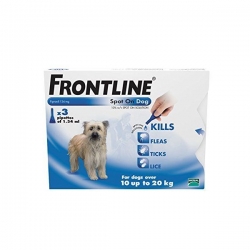Frontline Dog 10 - 20kg 3 pipette
Stock: Discontinued Line
Presentation
Spot-on solution. Clear amber solution.
Composition
Weight (kg): 10 - 20kg
Volume of unit dose (ml): 1.34
Fipronil (mg): 134
(S)-methoprene (mg): 120.60
Clinical Particulars
Target species
Dogs.
Indications for use
- To be used against infestations with fleas, alone or in association with ticks and/or biting lice.
- Treatment of flea infestations (Ctenocephalides spp.). Insecticidal efficacy against new infestations with adult fleas persists for 8 weeks. Prevention of the multiplication of fleas by inhibiting the development of eggs (ovicidal activity), larvae and pupae (larvicidal activity) originating from eggs laid by adult fleas for eight weeks after application.
- Treatment of tick infestations (Ixodes ricinus, Dermacentor variabilis, Dermacentor reticulatus, Rhipicephalus sanguineus). The product has a persistent acaricidal efficacy for up to 4 weeks against ticks.
- Treatment of infestations with biting lice (Trichodectes canis).
The product can be used as part of a treatment strategy for the control of Flea Allergy Dermatitis (FAD).
Contra-indications
In the absence of available data, the product should not be used on puppies less than 8 weeks old and/or weighing less than 2 kg.
Do not use on sick (e.g. systemic diseases, fever) or convalescent animals.
Do not use in rabbits, as adverse drug reactions, even mortality, could occur.
In absence of studies, the use of the product is not recommended in non-target species. This product is specifically developed for dogs. Do not use in cats and ferrets, as this could lead to overdosing.
Special warnings for each target species
Bathing/immersion in water within 2 days after application of the product and more frequent bathing than once a week should be avoided, as no study has been performed to investigate how this affects the efficacy of the product. Emollient shampoos can be used prior to treatment, but reduce the duration of protection against fleas to approximately 5 weeks when used weekly after application of the product. Weekly bathing with a 2% chlorhexidine medicated shampoo did not affect efficacy against fleas during a 6 week long study.
Dogs should not be allowed to swim in watercourses for 2 days after application. There may be an attachment of a few ticks. For this reason transmission of infectious diseases cannot be completely excluded if conditions are unfavourable. Fleas from pets often infest the animal’s basket, bedding and regular resting areas such as carpets and soft furnishings which should be treated, in case of massive infestation and at the beginning of the control measures, with a suitable insecticide and vacuumed regularly.
Special precautions for use in animals
Avoid contact with the animal’s eyes. It is important to make sure that the product is applied to an area where the animal cannot lick it off and to make sure that animals do not lick each other following treatment.
Special precautions to be taken by the person administering the product to animals
This product can cause mucous membrane, skin and eye irritation. Therefore, contact of the product with mouth, skin and eyes should be avoided. Animals or operators with a known hypersensitivity to insecticides or alcohol should avoid contact with the product.
Avoid contents coming into contact with the fingers. If this occurs, wash hands with soap and water. After accidental ocular exposure the eye should be rinsed carefully with pure water. Wash hands after use.
Treated animals should not be handled until the application site is dry, and children should not be allowed to play with treated animals until the application site is dry. It is therefore recommended that animals are not treated during the day, but should be treated during the early evening, and that recently treated animals are not allowed to sleep with owners, especially children.
Do not smoke, drink or eat during application.
Adverse reactions
Among the very rare suspected reactions, transient skin reactions at the application site (skin discoloration, local hair loss, itching, redness) and general itching or hair loss have been reported after use. Excessive salivation, reversible nervous signs (increased sensitivity to stimulation, depression, other nervous signs), vomiting or respiratory symptoms have also been observed after use. If licking occurs, a brief period of excessive salivation may be observed due mainly to the nature of the carrier. Do not overdose.
Use during pregnancy, lactation or lay
The product can be used during pregnancy and lactation.
Method of administration
Hold the pipette upright. Tap the narrow part of the pipette to ensure the contents remain within the main body of the pipette. Snap back the tip. Part the coat on the back of the animal at the base of the neck in front of the shoulder blades until the skin is visible. Place the tip of the pipette on the skin and squeeze the pipette several times to empty its contents completely and directly onto the skin in one spot.
Temporary changes to the coat (clumped/greasy hair) may be noted at the application site.
Overdose
No adverse effects were observed in target animal safety studies in 8 week old puppies, growing dogs and dogs weighing about 2 kg treated once at five times the recommended dose. The risk of experiencing adverse effects may however increase when overdosing, so animals should always be treated with the correct pipette size according to bodyweight.
Pharmacological particulars
The product is an insecticidal and acaricidal solution for topical use, containing an association of an adulticidal active ingredient, fipronil, in combination with an ovicidal and larvicidal active ingredient, (S)-methoprene.
ATCvet code: QP53AX65
Pharmacodynamic properties
Fipronil is an insecticide and acaricide belonging to the phenylpyrazole family. It acts by interacting with ligand-gated chloride channels, in particular those gated by the neurotransmitter gamma-aminobutyric acid (GABA), thereby blocking pre- and post-synaptic transfer of chloride ions across cell membranes. This results in uncontrolled activity of the central nervous system and death of insects or acarines. Fipronil kills fleas within 24 hours and ticks (Dermacentor reticulatus, Dermacentor variabilis, Rhipicephalus sanguineus, Ixodes scapularis, Ixodes ricinus, Haemaphysalis longicornis, Haemaphysalis flava, Haemaphysalis campanulata) and lice within 48 hours post-exposure.
(S)-methoprene is an insect growth regulator (IGR) of the class of compounds known as juvenile hormone analogues that inhibit the development of immature stages of insects. This compound mimics the action of juvenile hormone and causes impaired development and death of the developing stages of fleas. The on-animal ovicidal activity of (S)-methoprene results from either direct penetration of the eggshell of newly laid eggs or from absorption through the cuticle of the adult fleas. (S)-methoprene is also effective in preventing flea larvae and pupae from developing, which prevents contamination of the environment of treated animals with the immature stages of fleas.
Disposal
Any unused product or waste materials derived from such products should be disposed of in accordance with local requirements.
Fipronil and (S)-methoprene may adversely affect aquatic organisms. Do not contaminate ponds, waterways or ditches with the product or empty containers.
Legal Category
AVM GSL
You can see a directory of all veterinary medicines here
We acquired this data from the Noah Compendium, please see a link to this product here
If you have any queries please contact one of our Animal Medicines Advisors here
Your Review: Note: HTML is not translated!
Rating: Bad Good
Enter the code in the box below:




 5* Trustpilot Reviews
5* Trustpilot Reviews